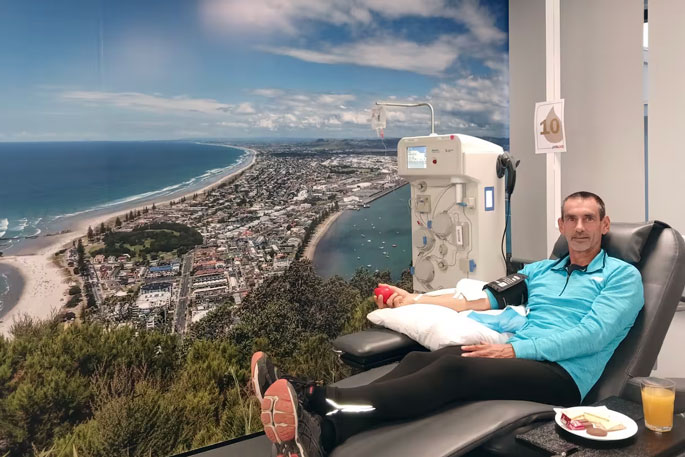When Nicholas Page first started working at Rotorua Hospital as a trainee medical laboratory scientist at age 18, he quickly learned how valuable blood donations were.
He says he spent “years” working in transfusion laboratories, “dishing out the product left, right, and centre in the small hours of the morning because the person in the theatre is bleeding everywhere”.
His career has been the main inspiration for becoming a regular donor.
Now 54, Nicholas has made about 85 blood and plasma donations throughout his life.
“It just was natural to actually give my arm and my blood to help fill the bank.”
This week is National Blood Donor Week which encourages people to join the New Zealand Blood Service’s (NZBS) lifesaving community, and to thank existing donors such as Page.
An event will take place at the recently opened $2.4 million NZBS centre on Cameron Road in Tauranga on August 15 where people can hear from experts and learn more about becoming a blood and plasma donor.
When blood is needed
Nicholas tells the Bay of Plenty Times he moved from Rotorua to Tauranga in the early 1990s and worked at Tauranga Hospital’s transfusion laboratory.
He says the most common situations in hospitals where people need blood donations are car accidents, traumas such as stabbings, obstetric complications, internal bleeds, ruptured aneurysms, and gastrointestinal bleeds.
Nicholas became a regular whole-blood donor in 1988, donating about three times per year.
However, he eventually started suffering from sport-induced anaemia after donating.
“I had a couple of spells where I had to stop donating for sort of a year at a time, go on iron pills, it just got a little bit complicated.”
That's one of the reasons he became a regular plasma donor about three years ago.
“I wasn’t contributing potentially as much as I would have liked.”
He donates plasma every three to four weeks.
Blood donations take 45 minutes to an hour and a plasma donation about 90 minutes, he says.
Nicholas – who now works in general practice for the Western Bay of Plenty Primary Health Organisation – says donating is “pain-free” after the initial “intense” and “quick prick” of the needle.
“The team at the blood service are amazing … if you want that feel-good community spirit and you’ve got a bit of time, and you want to make a difference to someone’s life who’s really going to be in need, it’s such a cool thing to do.”
What is plasma?
New Zealand Blood Service donor relations team leader Rachel Bowman says the Bay of Plenty has more than 3000 active donors, but it needed more to keep up with the rising demand for local blood and blood products.
Every week, 290 donations were needed in Tauranga.
One blood donation can save up to three lives while a plasma donation can be made into 11 different lifesaving products.
Plasma is the liquid component of the blood and a vital part of many people’s treatments for cancer, autoimmune diseases and other conditions.
Demand for plasma has risen by more than 30 per cent in the last three years and is projected to grow by 50 per cent in the next three years.
The rise in plasma demand is primarily due to the increased need for patients with autoimmune disorders who use IVIg products (concentrated solutions of antibodies).
The Blood Service needed to collect more than 2100 plasma donations every week to keep up with demand. On average it was short about 250 donations per week.
Plasma donation takes about 90 minutes.
Red cells and platelets are returned to the donor and only the plasma component is kept. People can donate plasma every two weeks.
- People who would like to register their attendance for Thursday’s event can email hannah.todd@nzblood.co.nz
- For information about how to book an appointment to donate blood, visit the NZ Blood website.



0 comments
Leave a Comment
You must be logged in to make a comment.